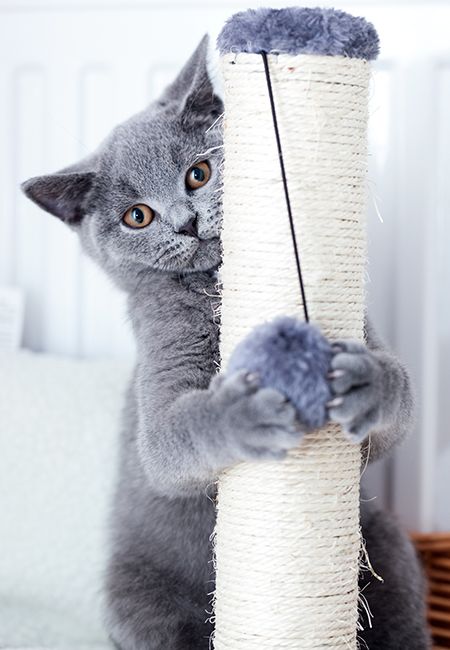Dale, Downing: Why veterinarians should say no to declawing—and what to say instead
Pet expert Steve Dale and pain management guru Dr. Robin Downing offer insight on some alternatives to feline onychectomy that you can share with your clients.
Photocreo Bednarek/stock.adobe.com

While more veterinarians are speaking out about the potentially harmful long-term effects of feline declawing (onychectomy), the profession remains divided about this controversial topic. Earlier this year, Gov. Andrew Cuomo made New York the first state to ban feline declawing, calling it a “cruel and painful procedure that can create physical and behavioral problems for helpless animals.”
While many veterinarians support the ban, others say the practice is necessary for immunocompromised clients and that if they don't provide declaw services, more cats will be relinquished to shelters and euthanized.
When cats are declawed, “we are creating pain, we are altering biomechanics, we are altering their activities of daily living … and we are interrupting natural behavior, because we know that scratching is a natural behavior,” says Robin Downing, DVM, MS, DAAPM, DACVSMR, CVPP, CCRP, owner of the Downing Center for Animal Pain Management in Windsor, Colorado, who is lecturing with certified animal behavior consultant and pet journalist Steve Dale at the Fetch dvm360 conference in San Diego this week.
Both Dale and Dr. Downing openly oppose feline onychectomy. Dale's message to veterinarians at the conference is that there are effective solutions that can be presented to clients as alternatives to declawing. He offers several tips and tools to help stop inappropriate scratching behavior.
'Cat scratchers are really important'
Scratching is a normal behavior for cats, and declawing is not a necessary procedure, according to the AVMA. “Scratching is acceptable, I believe,” Dale says. "Cats just need the right tools to help them scratch in the right places." That's where cat scratchers come in. Dale offers the following tips to share with clients.
Location is important. It's good to keep a cat scratching post near the front door because when pet owners come home, a cat can get excited and start scratching, Dale explains. He also recommends putting scratchers near windows and back doors.
Educate cats on how to use the scratchers. Many cats need help learning how to use a scratching post. You might need to “entice the kitten to climb up the post,” Dale says, noting that catnip can help with that in cats that are responders. “Sometimes people can gently put a cat's claws on the scratching board, or you can use toys to coax the cats,” Dale says. He warned that clients should “never punish the cats for scratching. Cats aren't so forgiving when their trust is broken from punishment.”
Make sure the scratcher is tall and sturdy. When it comes to scratching posts, height and sturdiness matter. A lot of scratching posts just aren't tall enough, Dale says. "Of course, taller posts are more expensive, but the value goes beyond protecting the couch," he says.
Make it fun and get creative. A large cat scratcher can serve as a feline playground and enrichment center as well as an outlet for scratching. Clients can add toys to make the experience more enjoyable, giving cats something to target with their natural predatory and play behaviors.
Tip for clients
Here are a few tools that can help clients manage scratching behaviors:
- Cover the couch with plastic to stop cats from scratching it.
- Keep the cat's claws trimmed.
- Use Sticky Paws, a double-sided adhesive that cats avoid, on strategic areas of furniture.
- Place a vinyl rug runner with the prickly side up in areas clients want cats to avoid-the material can be cut to fit the space.
Check out AVMA's cat owner tips here.
A pheromonal approach
Studies have shown that using a pheromone product (Feliscratch by Feliway-Ceva) may be associated with less unwanted scratching behavior, Dale says. The product contains an analog to the pheromone cats deposit from their paws when they scratch, as well as catnip to attract them to a scratching post or other appropriate scratching outlet. A blue dye provides a visual indicator that the post has been scratched.
In product studies, researchers found that Feliscratch attracted more than 80% of cats to use their scratching posts within the first week of use. Additionally, over 90% of cats never started destructive scratching when adopted into a new home using Feliscratch, according to a Ceva release.
The bottom line
Dr. Downing notes that since indoor cats live longer lives, “when we make a biomechanical alteration to them early in their life, … implications may not emerge to the naked eye until that cat is 10 or 12 or 18-but they will emerge.
“Ninety percent of cats 10 years of age or older have radiographic evidence of osteoarthritis, and altered biomechanics can make that worse,” she concludes.
That's why Dr. Downing and Dale have made it their mission to educate people about declawing and point them to more natural and pain-free alternatives.
“Cats would prefer to keep their toes,” says Dr. Downing.
